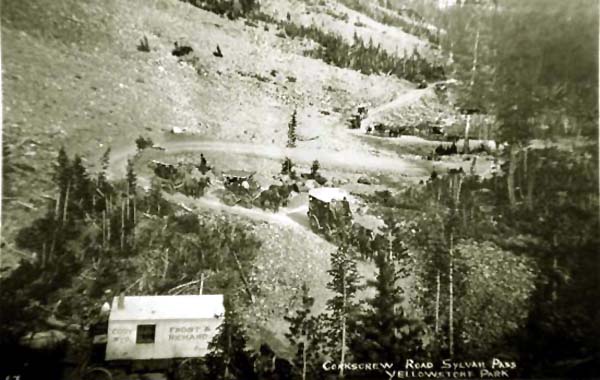
Frost and Richard Camping Train ascending Cody Road near Sylvan Pass. Photo by
F. J. Hiscock (attributed).
Construction of the Cody Road to Yellowstone in addition to tunnels required a number of
bridges. Near Syvan Pass, the camping train would traverse one of the more unusual
bridges along the road, the "Corkscrew."
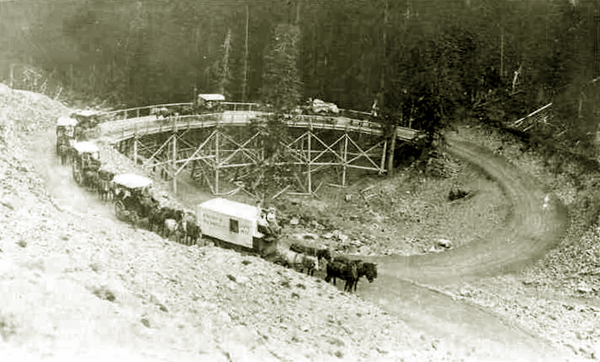
A Frost and Richard tour party heading to Yellowstone and crossing the "Corkscrew," Sylvan Pass Cody Road between 1909 and 1915, photo by F. J. Hiscock
The "Loop" or "Corkscrew" was originally constructed in 1903 and was replaced in 1919 by the structure in the next three photos.
Prior to 1916, motor cars were not permitted in Yellowstone National Park. Thus, early tourists going up the
Cody Road traveled by pack train or in spring Wagons.
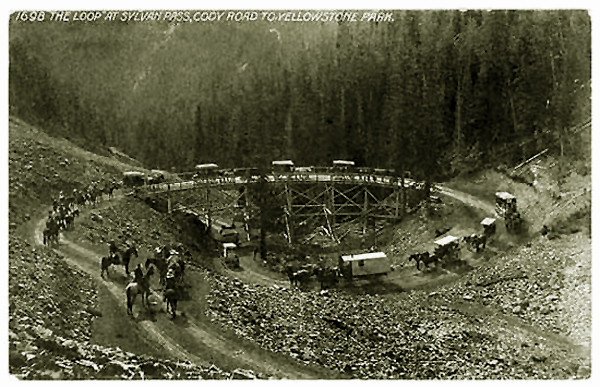
"A Frost and Richard tour party returning from
Yellowtone approx. 1915.
The surry-like vehicles are "spring wagons." The large closed van leading the parade in the above photos is the
mess and supply wagon.
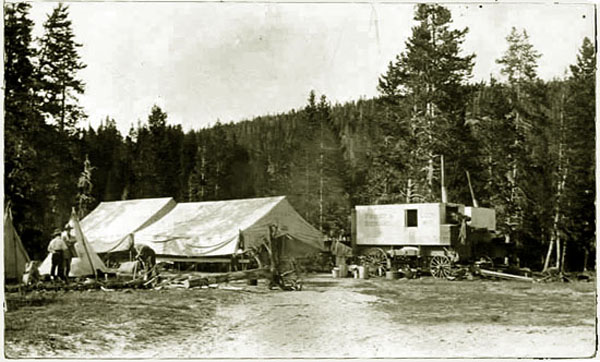
Frost and Richard camp showing the mess and supply wagon, Yellowstone between 1909 and 1915.
Yellowstone approx. 1915.
In 1916, the Federal Government required consolidation under government contract of services within
yellowstone. Independent tour companies such as Frost and Richard were effectively eliminated and replaced by the
Yellowstone Park Transportation Company which had exclsuive rights to public transportation within the
Park. The transportation was operated in conjunction with the three railroads which served the park,
the Union Pacific through West Yellowstone, the Northern Pacific through the Gardiner, and
the Burlington through Cody. The railroads provided much, if not all, the financing for a new fleet of
White touring cars and later busses. Although both Holm and Col. Cody at first used
"steamers" to go the their respective camps, these were later replaced with
cars using internal combustion engines. The advantage of the steam vehicles is that they were comparitively simple and easy to start.
The introduction of self-starters eliminated that advantage. In the automiblie museum
in Reno, there is a fully restored Stanley Mountain Carriage. Stanleys were used in Estes Park Colorado at the
Stanley Hotel.
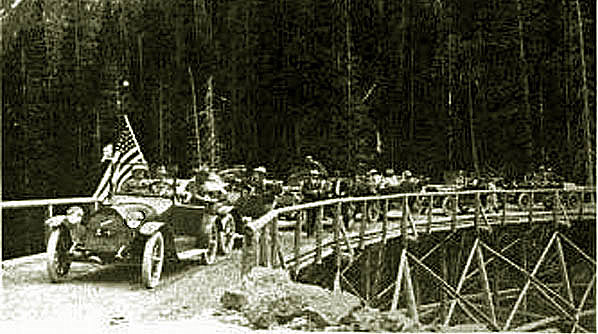
Cody Road, the "Loop", Sylvan Pass Cody Road, 1917
The above and next photo, show the first motor cars entering the park over the Corkscrew. The vehicles are stopped on the bridge
for a photo opportunity. In a careful view of the next photo, the flag is also visible.
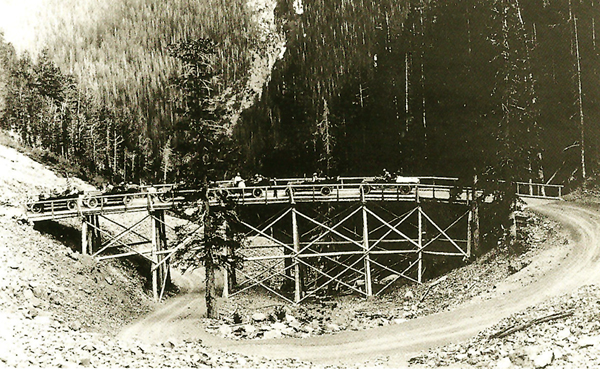
The first set of automobiles crossing
crossing the "Corkscrew," Sylvan Pass Cody Road, 1917.
In 1919, the original wooden Corkscrew as depicted below was replaced by a stone and earthenwork overpass.
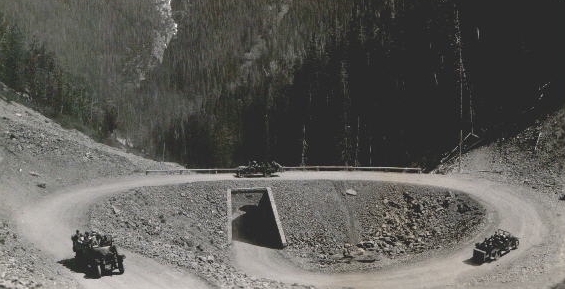
A tour company crossing the "Corkscrew," Sylvan Pass Cody Road subsequent to 1915, photo by F. J. Hiscock
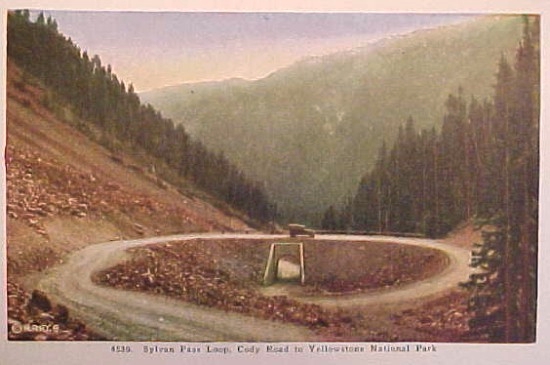
The "Corkscrew," Sylvan Pass, Cody Road, 1920's.
In 1929, the road was relocated to the side of the canyon and thus for
many years the structure was not visible from the road.
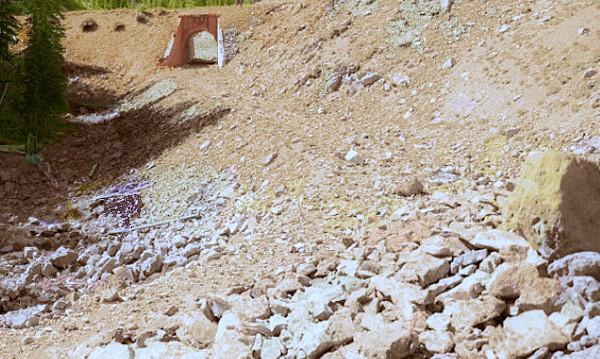
The "Corkscrew," Sylvan Pass,looking uphill, 1970's.
The remains of the old Cody Road are visible coming down the hill toward the rock on the right.
In the 2000's, the road was again reconstructed and
a pull-off was provided making the Corkscrew once again visible.
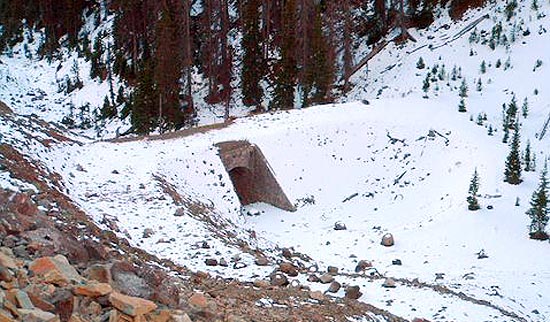
The "Corkscrew," Sylvan Pass, Sept. 2007. Photo courtesy of Michael Rooney.
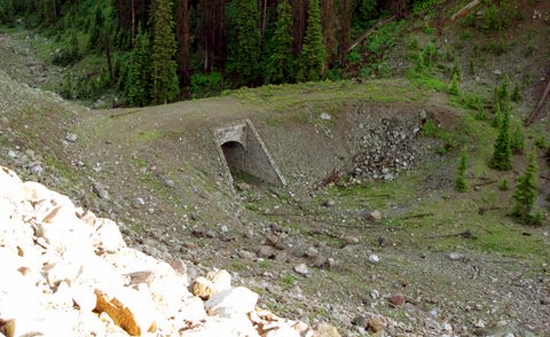
The "Corkscrew," Sylvan Pass, Sept. 2009. Photo courtesy of Michael Rooney.
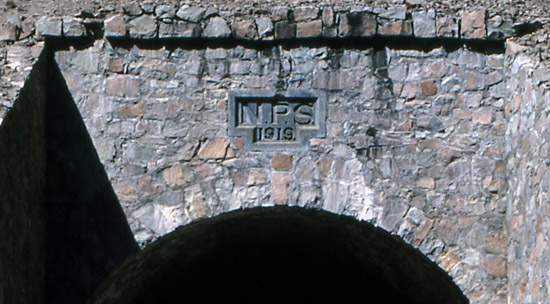
The Top Arch of the "Corkscrew," Sylvan Pass, showing National Park Service insignia stone .
Music this page:
"Tenting tonight on the Old Camp Ground,"
Composer: Walter Kittredge (1834-1905)
Arranged for harmonica and guitar by
Horse Creek Cowboy.
chorus:
Many are the hearts that are weary tonight
Wishing for the war to cease
Many are the hearts that are looking for the right
To see the dawn of peace
Tenting tonight, tenting tonight, tenting on the old camp ground
verses:
We're tenting tonight on the old camp ground
Give us a song to cheer
Our weary hearts, a song of home
And friends we love so dear
(chorus)
We've been tenting tonight on the old camp ground
Thinking of days gone by
Of the loved ones at home that gave us the hand
And the tear that said "Goodbye"
(chorus)
We are tired of war on the old camp ground
Many are dead and gone
Others been wounded long
(chorus)
We've been fighting today on the old camp ground
Many are lying near
Some are dead and some are dying
Many are in tears
(chorus)
"Tenting," an old Civil War song, was allegedly Colonel
Cody's favorite song and was often played in the Wild West show.
Next Page: Cody Road, Sylvan Pass.